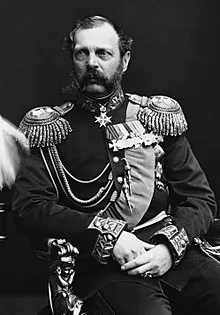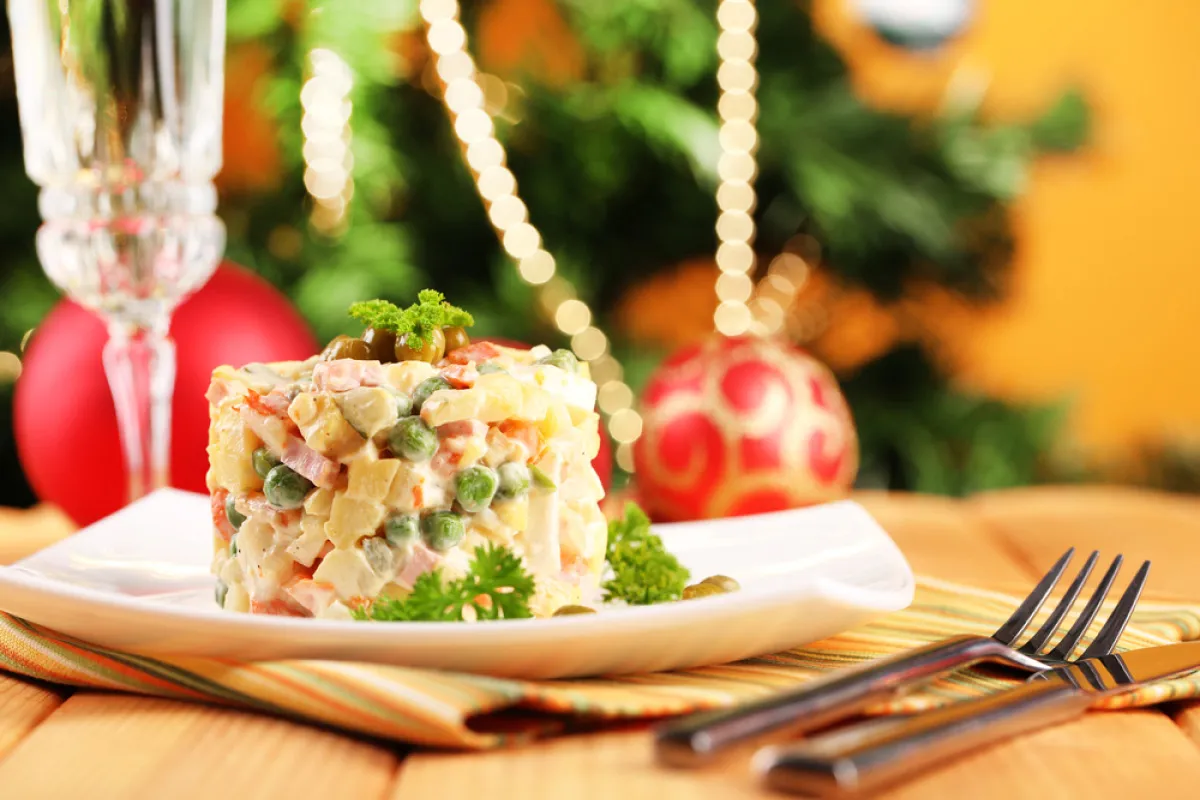Chapter Five: The mystery of the Russian Salad that was French
Давним давном в Русском царстве, в Русском государстве жил да был царь, у него были замечательний ресторан в французском стиле по имени Эрмитаж и его шеф-повар Lucien Olivier...

Tsar Alexander II Emperor of Russia
This story starts in the Russian Empire and is ice skating complicate and picturesque pirouettes all the way from Moscow, across Bulgaria, France and Spain through Belgium to make a final double axel in Alaska, USA. Today I am taking you back in 1864 to reveal the master skills of a French chef, Monsieur Olivier, who worked for the Russian Emperor Aleksandr II Nikolayevich. The time was of turbulent changes and demanded a ruler of strong character and diplomatic skills. It was back in those days, the Russian Tsar had taken the quest to significant reform as Emperor and was later called Alexander the Liberator for conducting the emancipation of Russia's serfs in 1861. He was also known for his reforms in reorganising the judicial system, setting up elected local judges, abolishing corporal punishment, promoting local self-government through the zemstvo system, imposing universal military service, ending some privileges of the nobility, and promoting university education…and for his gourmet taste. In addition, Alexander II was the King of Poland and the Grand Duke of Finland and the one who sold Alaska to the United States in 1867.
Liberation of Bulgaria. In April 1876 the Bulgarian population on the Balkans rebelled against Ottoman rule. The April Uprising was suppressed, causing a general outcry throughout Europe. Some of the most prominent intellectuals and politicians on the Continent, most notably Victor Hugo and William Gladstone, sought to raise awareness about the atrocities that the Turks imposed on the Bulgarian population. To solve this new crisis in the "Eastern question" a special conference was convened in Constantinople at the end of the year. The participants in the Conference failed to reach a final agreement. After the failure of the Constantinople Conference, at the beginning of 1877 Emperor Alexander II started diplomatic preparations with the other Great Powers to secure their neutrality in case there was a war between Russia and the Ottomans. The Russo-Turkish war, declared on 17 April 1877 (Russo-Turkish War of 1877–1878) ended with the signing of the preliminary peace Treaty of San Stefano on 19 February (3 March N.S.) 1878. For his social reforms in Russia and his role in the liberation of Bulgaria, Alexander II became known in Bulgaria as the "Tsar-Liberator of Russians and Bulgarians". A monument to Alexander II was erected in 1907 in Sofia in the "National Assembly" square, opposite to the Parliament building.
The personality of the Russian Tsar is deeply respected in Bulgarian history. Despite his otherwise pacifist foreign policy and his diplomatic contribution to the that stabilized European political situation, Alexander fought a brief war with the Ottoman Empire in 1877–78, pursued further expansion into Siberia and the Caucasus. In more peaceful and leisure days he enjoyed the delights Monsieur Olivier created at the Hermitage. On every New Year’s Eve and other major holidays, half of the world’s population is almost collapsing out of the dense pleasures of the tongue provided by Lucien Olivier’s most famous creation – The Imperial Olivier Salad.
In those days, many Russian aristos visited Paris, and would order dishes from their homeland, including the salade Olivier or Imperiale. Thus this hors d’ouvre became all the rage in the Paris of La Belle Époque, and thence it arrived in Spain, England and Italy. The common Spanish recipe has none of the aristocratic delights but it keeps the vegetables and tuna, all dressed in mayonnaise. The most curious thing is that in Russia there is a version of the Salade Olivier that is actually more popular...but that’s called American salad!
Monsieur Olivier’s salad that became the signature dish of the of the famous French-style Hermitage Restaurant in Moscow had its 155th anniversary in 2018. Invented in the 1860s by Lucien Olivier (1838-1883), a Moscow restaurateur and the very same owner of the restaurant in Trubnaya Square, initially, the salad was, but a dish called "Mayonnaise from Poultry". Olivier’s gourmet recipe consists of boiled, cut and laid on a plate fillets of grouse and partridges and alternately arranged with jelly cubes of poultry broth. Boiled crayfish tails and veal tongue slices were placed next to these and flavoured with Provencal sauce. The center of the plate was decorated with cooked potatoes and marinated cornichons, decorated with slices of hard-boiled eggs. According to the chef, the central "hill" was suiting purely aesthetic purposes.
The Crazy thing done…for Life
To Lucien Olivier’s not very pleasant surprise, he saw that his intricately decorated dainty of "Mayonnaisefrom Poultry" was immediately mixed with a spoon by lots of Russian ignoramuses who enjoyed eating this mixture. Naturally, that horrified the chef and it’s a mystery under what circumstances he had made the decision to stir all the ingredients together and abundantly flavor them with mayonnaise. A chef’s horror taking the shape of a massive success!

Russian Salad
A salad so good that every nation claims a name and a version on it
During Franco’s dictatorship in Spain (1936-1976), Monsieur Olivier’s salad was very popular under the name Russian Salad, but the fascists could not tolerate its name as they deemed such a name is a “devil incarnate on a plate” and very quickly it was renamed for a second time a National Salad. Quite understandably, some ingredients were swapped for others still renowned cook researches insist that the original would be close to a mound of potatoes mixed with gherkins placed in the centre of a platter, covered with hard-boiled egg slices for decoration. Around this mound, the chef arranged slices of simmered grouse and partridge breast, small aspics moulded into bird shapes, simmered crayfish tails, and slices of tongue, all of which was drizzled with a mayonnaise sauce. No one really knows the complete recipe Lucien Olivier has created, as the chef hadn’t allowed anyone watch him making it. Nevertheless, most food historians seem to agree that Olivier’s mayonnaise sauce for it really was the key that no one seemed able to reproduce.
The salad to which Olivier gave his name involves cold game (or salmon in Lent) and has a more sophisticated dressing.Davidson, Alan. The Penguin Companion to Food. London: The Penguin Group, 2002. Page 810.
The post Russian Revolution story of the Russian Salad introduces less gourmet compared to the political regime changes that have gone beyond the borders of the Soviet Union. Nowadays, the updated and even more popular version could be tried even in Goa, India where Chowder Singh is giving us a hint how do they serve it there.
Potato and Peas replaced the fancy ingredients along with some veggies and fresh meat by sausage/boiled meat. It was all mixed up in mayonnaise to a more accessible recipe and spread to many parts of the world to be the new Soviet version of the dish.Goa, India

The salad that became so famous, was tried by Tsar Alexander II of Russia himself at His Majesty's visits at the Hermitage, Monsieur Olivier’s restaurant. Lucien Olivier died in 1883 and took the secret of his dish to his grave, as he never wrote the recipe, and none of his assistants saw how he prepared it. His restaurant, The Hermitage, finally closed in 1905.
… После того тут льди устроили пир на весь мир и жили долго и счастливо.



Please consider these most amazing and supportive people as witnesses:
@c0ff33a / @derangedvisions - @enginewitty
@surpassinggoogle / @steemgigs - @yehey
@curie / @markangeltrueman - @good-karma
@therealwolf - @thekitchenfairy
@jatinhota, @guiltyparties, @noblewitness and
